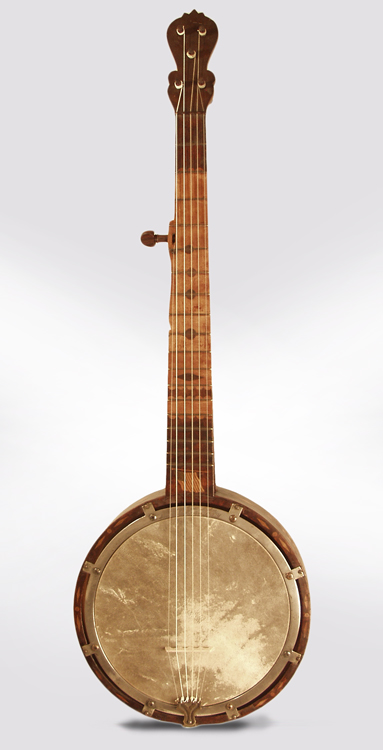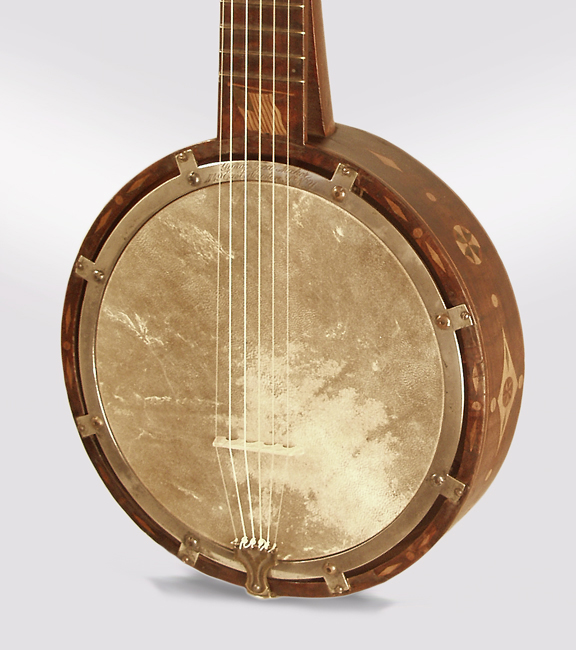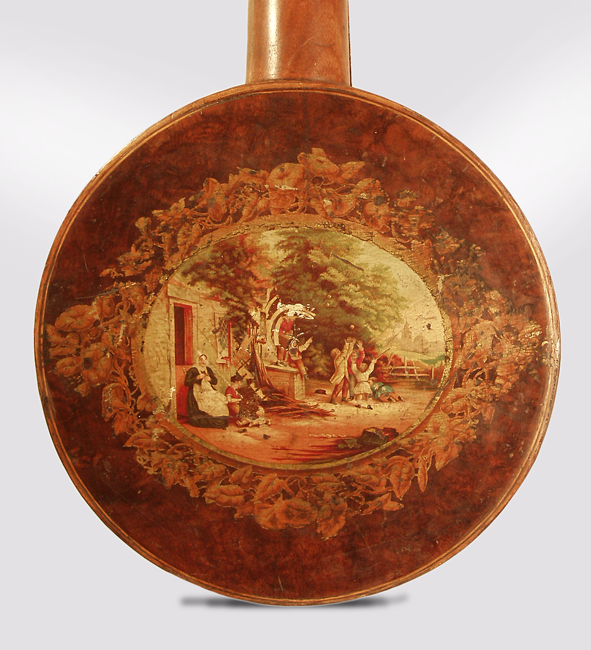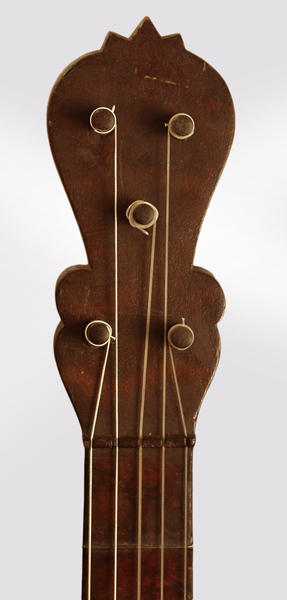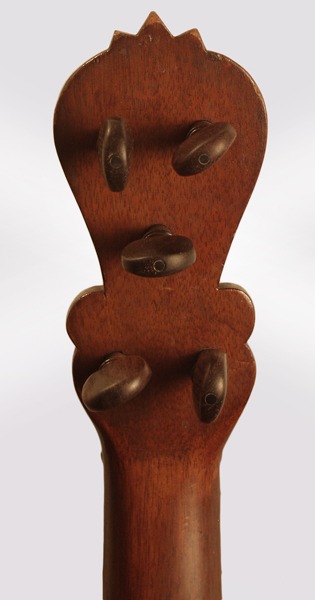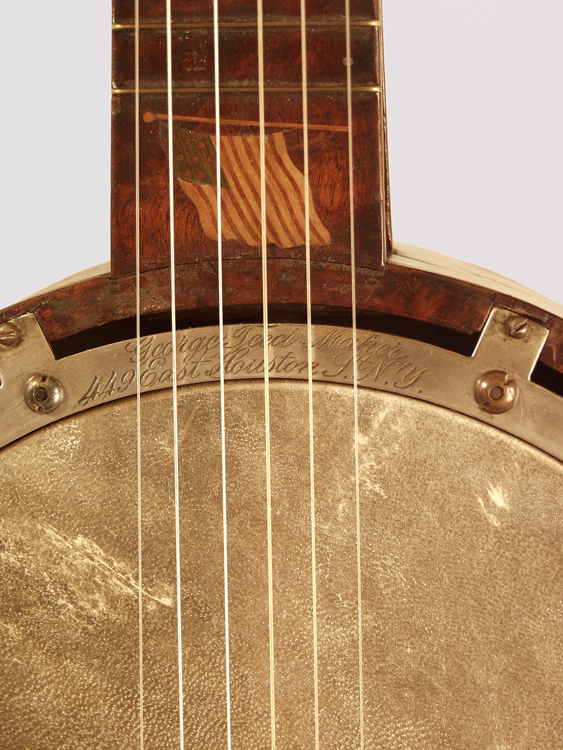George Teed 6 String Minstrel Banjo , c. 1870's
An important and historical instrument.
This item has been sold.
Item # 2786
Prices subject to change without notice.
George Teed 6 String Minstrel Banjo, c. 1870's, made in New York City, natural varnish finish, walnut neck and rim.
This most striking mid-19th century instrument is a very rare and unusually beautiful six-string American banjo by a somewhat obscure but incredibly forward-thinking New York-based artisan, George Teed. Presaging both the English Zither Banjo of the 1890's and the 1920's Vegavox, the design incorporates a deep-walled body with a metal rim carrying the skin head sunk into it.
Banjos of this type were first patented by Teed in the early 1860's, and this is a particularly striking example of his best work with a high level of decoration. Teed's inventions were perhaps too far ahead of their time and too sophisticated to gain wide acceptance; The Dobson brothers in New York gained achieved much more success with closed-back banjos of a similar concept while Teed and his innovations are hardly remembered.
Teed's first patent was issued in April 1862; this is one of the very earliest of banjo-related patents and actually sets the tone for the next 75 years of fretted invention, promising "a more powerful and finer tone to the instrument". Teed's idea for a separate internal rim and tension hoop set inside an outer body is described here in a basic form.
He re-applied for a newer patent in late 1884, covering the details of a much more sophisticated application of the idea, with a closed back and more elaborate specialized hardware. This was granted in March 1885. Teed had by this time also settled on six strings, which was one more than most other contemporary American makers were using!
While Teed's name is not well known even to banjo enthusiasts, based on these designs he is one of the most important early figures in developing the banjo from its crude minstrel roots into a sophisticated and mechanically exacting instrument.
George Teed was born in 1824; in the time of the 1860 census, he was working on the Lower East Side of Manhattan as a wood turner, the official profession of most early banjo makers. He appears to have spent much of his working life on East Houston Street in New York's old 11th Ward, noted in a contemporary article as "the most thickly populated district in the world, not excepting the densely crowded parts of Pekin(g)".
The address engraved on this particular banjo is 449 East Houston Street, down close to the East River; the 1880 census records an address of 426 East Houston. At the time the 11th Ward was heavily populated with German immigrants and boasted 346 saloons, one for every 200 residents! Presumably there were some banjo players active among the nightly drinking crowds, so Teed may have had a ready market for his instruments close to home!
This particular banjo is far too fancy (and expensive-looking) to have been most players' choice for entertaining a rowdy beer-drinking audience; indeed it appears to have likely been a specially-made presentation piece. The most unusual feature is a very elaborate rural domestic scene rendered in applique form on the back of the body. This depicts a mother sitting and sewing just outside the front door of a family cabin while eight children engage in various forms of play around her. In the distance a country church steeple is visible. The scene is edged with a gold leaf floral pattern in typical Victorian style.
This artwork covers most of the resonator back, overlaid on top of some inlaid wood marquetry decoration, so it may have been added after the instrument was completed. Perhaps one of Teed's customers living on the teeming Lower East Side wanted an instrument to remind them of a more bucolic time and place, and so ordered this customized feature.
The rest of the banjo is also quite an elaborate creation. There is finely-executed wood marquetry around the sides and top of the rim, and contrasting wood inlay on the fingerboard. This is more typical of other known Teed-made banjos. A most fascinating feature is an American flag inlaid into the board just above the rim in colored wood. This may indicate a connection with the nation's centennial celebrations of 1876, which produced many similarly-marked items.
The neck is built up of several wood sections pieced together, with a contrasting lighter wood fingerboard inset from frets 2-15. Another fascinating feature is a particularly finely-executed fifth-string peg setup that feeds the string into a recessed well in the fingerboard where it meets the tuning peg. The headstock is hand carved in a multi-curved shape (it is actually a bit asymmetrical!) and carries a further five violin-style tuning pegs.
There is a hollow space under the fingerboard beneath the last 6 frets, a relic of the older style scooped rim joints. The banjo's neck is fretted with brass frets, which was a relatively new (and fairly expensive!) feature at the time. The banjo's metal hardware is very finely wrought as well; Teed being a woodworker by trade likely subcontracted the metalwork, but it is to a very high standard.
Despite appearances, this is not a top-tension banjo like some Dobsons of the same period. The head is sandwiched between an inner and outer circular rim, tensioned with large screws tightened from beneath. The ends of these screws are of smaller diameter and pass through the plated top flange, where they are secured by small rounded grommets with rounded heads and two notches in the edge. That flange is screwed to the rim through metal tabs countersunk into the wooden edge. Each internal piece is hand-made and specifically marked for one of the eight rim positions!
The tailpiece is also a small work of art, made of brass and pinned to the base so it swivels out of the way to allow the rim to be dismounted. All this workmanship is beautifully executed, as is engraving on the top flange piece reading "George Teed Maker, 449 East Houston Street NY" in flowing script.
Unlike some of the other few surviving Teed banjos, this one does not have markings referencing either patent date, suggesting it was built sometime between the two.
This Teed banjo is one of the most historically interesting and aesthetically pleasing 19th century instruments we have had the pleasure to handle. Above and beyond that, it is fully functional and a downright pleasing instrument to actually play as well. Set up with a 19th century style skin head and authentic gut strings, this banjo has a brighter sound than the standard minstrel banjo, even in the correct "old" low "A" tuning.
While we don't exactly recommend taking it out to entertain the rowdy crowd in an 1870's style saloon, this is a performance-worthy banjo for the dedicated historical player. It is also a museum-quality piece, and we are pleased and honored to have the opportunity to offer this unique and important piece of local New York banjo history to our customers.
Overall length is 35 3/8 in. (89.8 cm.), 9 1/2 in. (24.1 cm.) diameter head, and 2 7/8 in. (7.3 cm.) in depth, measured at side of rim. Scale length is 25 1/2 in. (648 mm.).
While it shows many signs of age, for its time period this is an exceptionally well-preserved instrument.
All the hardware is intact and complete, carrying a lovely patina with some typical plating wear but no major loss. Overall on the wooden areas there are numerous small rubs, chips and dings but the finish is still substantially intact.
The violin-style tuning pegs are period-correct style reproductions and function well; the bridge is a reproduction 19th century Cole style with arched cutaways between the multiple feet.
The fragile artwork on the back has some overall deterioration but is again substantially intact with several small sections partially flaked away.
No structural issues, functional and beautiful; suitable for play, display, and further centuries of appreciation. Excellent - Condition.
This most striking mid-19th century instrument is a very rare and unusually beautiful six-string American banjo by a somewhat obscure but incredibly forward-thinking New York-based artisan, George Teed. Presaging both the English Zither Banjo of the 1890's and the 1920's Vegavox, the design incorporates a deep-walled body with a metal rim carrying the skin head sunk into it.
Banjos of this type were first patented by Teed in the early 1860's, and this is a particularly striking example of his best work with a high level of decoration. Teed's inventions were perhaps too far ahead of their time and too sophisticated to gain wide acceptance; The Dobson brothers in New York gained achieved much more success with closed-back banjos of a similar concept while Teed and his innovations are hardly remembered.
Teed's first patent was issued in April 1862; this is one of the very earliest of banjo-related patents and actually sets the tone for the next 75 years of fretted invention, promising "a more powerful and finer tone to the instrument". Teed's idea for a separate internal rim and tension hoop set inside an outer body is described here in a basic form.
He re-applied for a newer patent in late 1884, covering the details of a much more sophisticated application of the idea, with a closed back and more elaborate specialized hardware. This was granted in March 1885. Teed had by this time also settled on six strings, which was one more than most other contemporary American makers were using!
While Teed's name is not well known even to banjo enthusiasts, based on these designs he is one of the most important early figures in developing the banjo from its crude minstrel roots into a sophisticated and mechanically exacting instrument.
George Teed was born in 1824; in the time of the 1860 census, he was working on the Lower East Side of Manhattan as a wood turner, the official profession of most early banjo makers. He appears to have spent much of his working life on East Houston Street in New York's old 11th Ward, noted in a contemporary article as "the most thickly populated district in the world, not excepting the densely crowded parts of Pekin(g)".
The address engraved on this particular banjo is 449 East Houston Street, down close to the East River; the 1880 census records an address of 426 East Houston. At the time the 11th Ward was heavily populated with German immigrants and boasted 346 saloons, one for every 200 residents! Presumably there were some banjo players active among the nightly drinking crowds, so Teed may have had a ready market for his instruments close to home!
This particular banjo is far too fancy (and expensive-looking) to have been most players' choice for entertaining a rowdy beer-drinking audience; indeed it appears to have likely been a specially-made presentation piece. The most unusual feature is a very elaborate rural domestic scene rendered in applique form on the back of the body. This depicts a mother sitting and sewing just outside the front door of a family cabin while eight children engage in various forms of play around her. In the distance a country church steeple is visible. The scene is edged with a gold leaf floral pattern in typical Victorian style.
This artwork covers most of the resonator back, overlaid on top of some inlaid wood marquetry decoration, so it may have been added after the instrument was completed. Perhaps one of Teed's customers living on the teeming Lower East Side wanted an instrument to remind them of a more bucolic time and place, and so ordered this customized feature.
The rest of the banjo is also quite an elaborate creation. There is finely-executed wood marquetry around the sides and top of the rim, and contrasting wood inlay on the fingerboard. This is more typical of other known Teed-made banjos. A most fascinating feature is an American flag inlaid into the board just above the rim in colored wood. This may indicate a connection with the nation's centennial celebrations of 1876, which produced many similarly-marked items.
The neck is built up of several wood sections pieced together, with a contrasting lighter wood fingerboard inset from frets 2-15. Another fascinating feature is a particularly finely-executed fifth-string peg setup that feeds the string into a recessed well in the fingerboard where it meets the tuning peg. The headstock is hand carved in a multi-curved shape (it is actually a bit asymmetrical!) and carries a further five violin-style tuning pegs.
There is a hollow space under the fingerboard beneath the last 6 frets, a relic of the older style scooped rim joints. The banjo's neck is fretted with brass frets, which was a relatively new (and fairly expensive!) feature at the time. The banjo's metal hardware is very finely wrought as well; Teed being a woodworker by trade likely subcontracted the metalwork, but it is to a very high standard.
Despite appearances, this is not a top-tension banjo like some Dobsons of the same period. The head is sandwiched between an inner and outer circular rim, tensioned with large screws tightened from beneath. The ends of these screws are of smaller diameter and pass through the plated top flange, where they are secured by small rounded grommets with rounded heads and two notches in the edge. That flange is screwed to the rim through metal tabs countersunk into the wooden edge. Each internal piece is hand-made and specifically marked for one of the eight rim positions!
The tailpiece is also a small work of art, made of brass and pinned to the base so it swivels out of the way to allow the rim to be dismounted. All this workmanship is beautifully executed, as is engraving on the top flange piece reading "George Teed Maker, 449 East Houston Street NY" in flowing script.
Unlike some of the other few surviving Teed banjos, this one does not have markings referencing either patent date, suggesting it was built sometime between the two.
This Teed banjo is one of the most historically interesting and aesthetically pleasing 19th century instruments we have had the pleasure to handle. Above and beyond that, it is fully functional and a downright pleasing instrument to actually play as well. Set up with a 19th century style skin head and authentic gut strings, this banjo has a brighter sound than the standard minstrel banjo, even in the correct "old" low "A" tuning.
While we don't exactly recommend taking it out to entertain the rowdy crowd in an 1870's style saloon, this is a performance-worthy banjo for the dedicated historical player. It is also a museum-quality piece, and we are pleased and honored to have the opportunity to offer this unique and important piece of local New York banjo history to our customers.
Overall length is 35 3/8 in. (89.8 cm.), 9 1/2 in. (24.1 cm.) diameter head, and 2 7/8 in. (7.3 cm.) in depth, measured at side of rim. Scale length is 25 1/2 in. (648 mm.).
While it shows many signs of age, for its time period this is an exceptionally well-preserved instrument.
All the hardware is intact and complete, carrying a lovely patina with some typical plating wear but no major loss. Overall on the wooden areas there are numerous small rubs, chips and dings but the finish is still substantially intact.
The violin-style tuning pegs are period-correct style reproductions and function well; the bridge is a reproduction 19th century Cole style with arched cutaways between the multiple feet.
The fragile artwork on the back has some overall deterioration but is again substantially intact with several small sections partially flaked away.
No structural issues, functional and beautiful; suitable for play, display, and further centuries of appreciation. Excellent - Condition.
